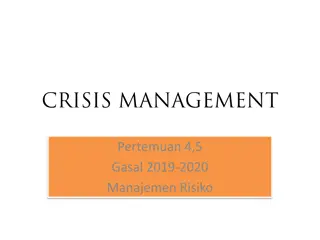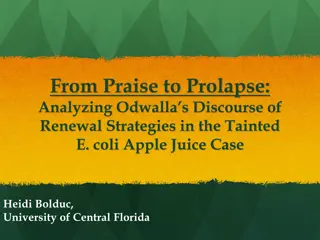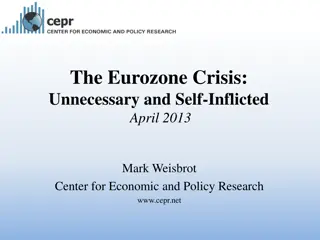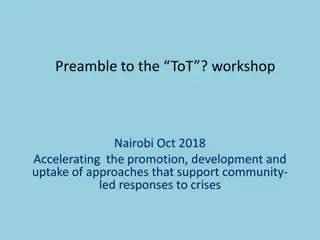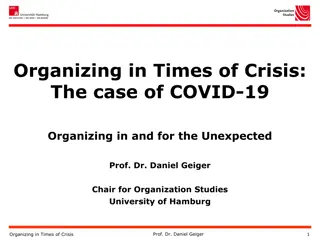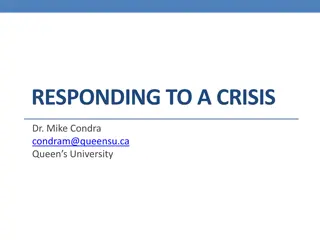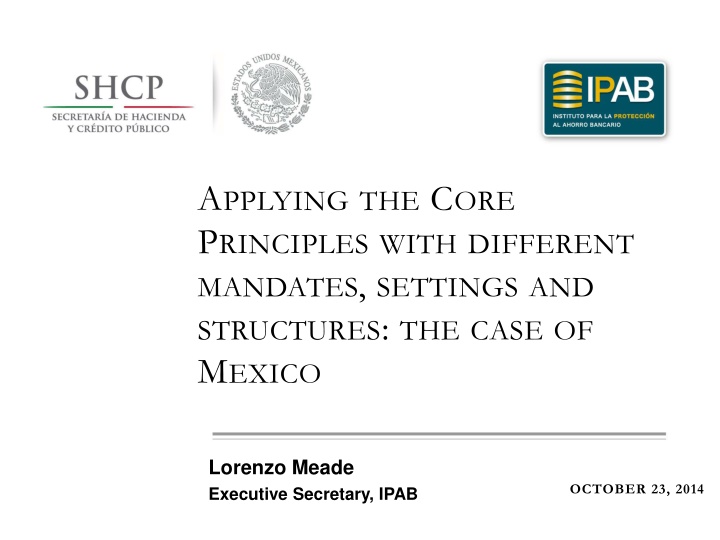
Applying Core Principles in Evolving Financial Crisis Response
With a focus on Mexico, this content delves into the evolving role of Deposit Insurance Systems (DIS) in financial crisis scenarios, detailing responses, changes in mandates, and the overview of IPAB. The narrative explores the application of core principles with different mandates, settings, and structures, emphasizing the recent crisis impact on deposit insurance and regulatory frameworks.
Download Presentation

Please find below an Image/Link to download the presentation.
The content on the website is provided AS IS for your information and personal use only. It may not be sold, licensed, or shared on other websites without obtaining consent from the author. If you encounter any issues during the download, it is possible that the publisher has removed the file from their server.
You are allowed to download the files provided on this website for personal or commercial use, subject to the condition that they are used lawfully. All files are the property of their respective owners.
The content on the website is provided AS IS for your information and personal use only. It may not be sold, licensed, or shared on other websites without obtaining consent from the author.
E N D
Presentation Transcript
APPLYING THE CORE PRINCIPLES WITH DIFFERENT MANDATES, SETTINGS AND STRUCTURES: THE CASE OF MEXICO Lorenzo Meade Executive Secretary, IPAB OCTOBER 23, 2014
THE EVOLVING ROLE OF DIS: MEXICO AND ABROAD Financial Crisis BCBS/IADI Core Principles Updated Core Principles MX pilot test CP Methodology Key Attributes 2004 2006 2008 2010 2012 2014 G20 Summit Mexico Financial Reform Insolvent Bank Liquidation PCA Bank Resolution CESF
THE RECENT FINANCIAL CRISIS AND DEPOSIT INSURANCE Role of deposit insurance system since the recent financial crisis Relevance of international financial standards Importance of coordination between authorities 2
RESPONSE TO THE CRISIS AND CHANGES IN DIS MANDATES International response o Key Attributes o Crisis Management Groups o FSB Peer Reviews on DIS and on Resolution Regimes and recommendations to IADI on additional guidance o Updating the Core Principles 3rdstage: Mexico s Financial Reform package, includes: o Strengthening of the Bank Resolution Framework o Special regime for Insolvent Bank Liquidation 3
IPAB OVERVIEW IPAB Public agency Deposit Insurer and Resolution Authority Ex-ante funding system Flat rate premium fees charged to banks Coverage Limit: 400,000 UDIs ~ USD $150,000 Banking system: 47 commercial banks Powers and mandate enable IPAB to implement any of the following resolution methods: Deposit reimbursement Transfer of assets and liabilities Bridge bank Open bank assistance (in case of systemic risk) o o o o o 4
THE FORMER CORE PRINCIPLES 1. 2. 3. Mandate 4. Powers 5. Governance 6. Relationships with other safety-net participants 7. Cross-border issues 8. Compulsory membership 9. Coverage 10. Transitioning from a blanket guarantee to a limited coverage deposit insurance system 11. Funding 12. Public awareness 13. Legal protection 14. Dealing with parties at fault in a bank failure 15. Early detection and timely intervention and resolution 16. Effective resolution processes 17. Reimbursing depositors 18. Recoveries Public policy objectives Mitigating moral hazard 5
CP 3: MANDATE Observation: o Minor differences between the IPAB s mission statement and law could be clarified, mandate not entirely consistent with stated public policy objectives (i.e. mandate of protecting small-scale depositors in conflict with high coverage limit) Actions: o 2011: mission statement modified to guarantee bank deposits, primarily of depositors small and medium-sized 6
CP 9: COVERAGE Observation: o The high level of coverage per depositor appears excessive, making the mitigation of moral hazard more challenging. Actions: o In the wake of the crisis, it was determined that coverage was appropriate if the large majority of depositors across banks are fully protected while leaving a substantial proportion of the value of deposits unprotected 7
CP 11: FUNDING Observation: o Accumulation of a Fund is hampered by payment of legacy debt that stems from 1994-1995 crisis o The Fund has no target level o Access to extraordinary funding is conditional and may require a period of time to enact Actions: IPAB s Governing development of a strategic project to determine adequate fund size and the timeframe required to implement it o 2011: Board approved the o Extraordinary funding arrangements: under review Unresolved: 8 o Legacy debt payment: issue of public policy
CP 15: EARLY DETECTION, TIMELY INTERVENTION AND RESOLUTION Observation: o Uncertainty exists about the ability of shareholders to halt a resolution process through judicial injunctions (amparos) Actions: o 2013: Law on Judicial Injunctions (Ley de Amparo) was modified to establish that resolution measures cannot be halted by shareholders through judicial injunctions. 9
CP 16: EFFECTIVE RESOLUTION PROCESSES Observation: o Bank deterioration may turn out to be sooner than expected. o Bank commercial insolvency regime Actions: insolvency may lead to liquidation under o 2014: Insolvent bank liquidation process is implemented 10
CP 17: REIMBURSING DEPOSITORS Observation: o Ability of IPAB to conduct on-site examinations, the introduction of standardized elimination of claims form should reduce payout periods Actions: data templates and o 2014: IPAB is granted the power to carry out direct inspection visits and the claim form for depositor reimbursement is eliminated 11
THE PROPOSED CORE PRINCIPLES 1. 2. 3. Governance 4. Relationships with Other Safety-Net Participants 5. Cross-border Issues 6. Deposit Insurer s Role in Contingency Planning and Crisis Management 7. Membership 8. Coverage 9. Sources and Uses of Funds 10. Public Awareness 11. Legal Protection 12. Dealing with Parties at Fault in a Bank Failure 13. Early Detection and Timely Intervention 14. Failure Resolution 15. Reimbursing Depositors 16. Recoveries Public policy objectives Mandate and Powers 12
POSSIBLE FUTURE CHALLENGES FOR THE IPAB Governance Operational independence (composition of Governing Board and term limits) Cross-border issues Cooperation agreements with deposit insurers from home countries of all foreign banks operating in Mexico (as subsidiaries) Coverage Regular revision of coverage level Sources and uses of Funds Pre-arranged sources of liquidity funding Reimbursing Depositors Reimbursement within 7 days (in practice, but not in law) o o o o o 13
CONCLUSIONS It is important to note that, as a result of aforementioned changes and reforms, Mexico maintains an updated deposit insurance system and bank resolution regime. In addition, the financial reform allowed us to shorten timeframes in the case of an insolvent bank liquidation. Evidence of this is our recent experience with a bank resolution, which demonstrated that the process works to allow for the orderly and timely exit of a bank from the system. As such, and notwithstanding the foreseen challenges that I have mentioned, we do not consider these as material obstacles to a prompt and orderly bank resolution process. the 14
www.ipab.org.mx https://encrypted-tbn2.gstatic.com/images?q=tbn:ANd9GcTdPkmEmar2OBdnauknNHDqtdNU8FAlkkVjrMEOgUHxHRYkvGsr @IPAB_mx https://encrypted-tbn2.gstatic.com/images?q=tbn:ANd9GcTdPkmEmar2OBdnauknNHDqtdNU8FAlkkVjrMEOgUHxHRYkvGsr @LorenzoJMeade



